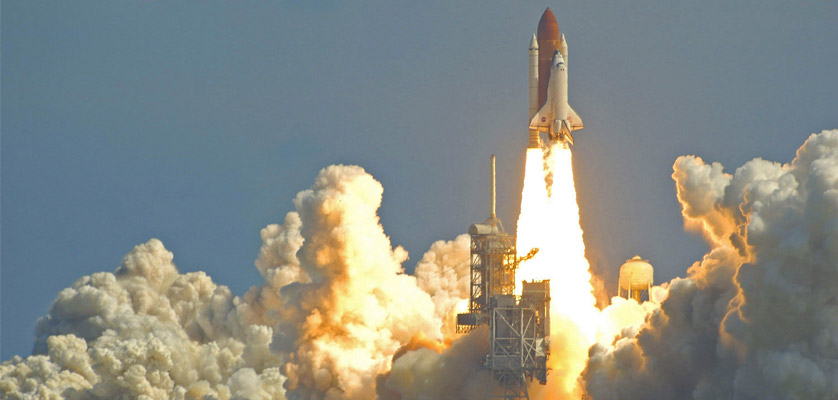It is Rocket Science!
We've all heard the phrase, "It isn't rocket science!" - usually applied to some everyday situation when a person is struggling with a relatively simple task, but when it comes to the use of hydraulics in space - yes, it really is rocket science!
Not only do hydraulics work in space, they're also an integral part of the technology required to operate space vehicles and complete missions. Anyone with a knowledge of hydraulics will know that the simplest system operates with just three parts: a cylinder, a pump and fluid.
It sounds basic, but perhaps surprisingly, the most complicated aspect is the fluid. Theoretically, any fluid can be used to generate the action - even your cup of tea! Of course, in practice, a special fluid such as hydraulic oil is used, due to its high heating properties.

© Kim Warden / Adobe Stock
What do hydraulics power in space?
While using hydraulics on earth can be relatively simple, everything becomes more complicated in space. The NASA Shuttle has three hydraulics systems to provide the pressure for positioning. They are designated independently as one, two and three and consist of parts that are rather more complex than the simple system on earth.
Components include the main hydraulic pump, hydraulic filters, the hydraulic reservoir, control valves, a hydraulic bootstrap accumulator, the hydraulic Freon-21 heat exchanger, electrical heaters and an electrical circulation pump.
The hydraulic system provides the three main engines' thrust vector control, the propellant control of numerous valves, retracts the external tanks, controls the speed of the rudder and the brakes, and disconnects the umbilical connections at the tank jettison.
Hydraulic system one powers the deployment of the main and nose landing gear, and provides nose wheel steering. Systems one and two combine to power the landing gear brakes. Each hydraulic system's main hydraulic pump is a variable displacement type, operating at 3,900 revolutions per minute when driven.
These multiple operations mean the hydraulic systems in space have to be considerably more complicated than most of the basic systems on earth.
How do the systems work?
While each hydraulic pump on the Shuttle is independent, each system works together in one way or another, with one task leading on to another.
As an example of how inter-dependent they are, if power was lost in hydraulic systems two and three, this would mean half the braking power of each wheel would be lost, creating an emergency situation.
Other applications of hydraulic systems are in operation in the International Space Station. Although the number of hydraulic systems in the space station isn't public knowledge, it is known that one has a key role in the loading boom.
There's also a complex hydraulic system in place that operates some of the International Space Station’s manoeuvring functions. It's similar to the system used on the Space Shuttle, although considerably more vast.
Does zero gravity affect hydraulics?
Despite hydraulic systems being crucial for space shuttles, it remains a challenge to keep the system properly maintained in zero gravity. The temperature variations of space also make it incredibly difficult to keep the hydraulic systems' fluid state constant.
Scientists are continually researching and developing means of keeping the space station operational in the longer term, due to the challenges of zero gravity. The challenges that must be overcome include massive temperature variations of hundreds of degrees and the vacuum, as well as the lack of gravity.
Care must be taken that the liquid particles of the hydraulic system can't escape, as they could contaminate the electrical instruments and compromise the safe operation of the system. It's incredibly hard to trap the liquid, as it's floating in a vacuum.
In terms of the temperature, when the space station is facing the sun, the temperature can rise to a staggering 1,200°C. This contrasts sharply to when it's in the shadow, as the temperature can plummet by -1,500°C. Due to the temperature changes, the properties of the liquid, including viscosity, bulk modulus and lubrication, change dramatically too.
This means that electrical heaters are required to keep the liquid at a constant temperature. In addition, a servo control feedback loop is also necessary to accurately control the actuator's movement.
Main challenges
Without gravity, the designers must take complex steps to connect the reservoir to an external gaseous pressure source to stop a vacuum from developing during the pump's suction.
Although it is obviously costly to maintain the space station, the more pressing issue is the technical challenge of keeping the hydraulics properly maintained in space. There is only limited power available through solar panels and one of the challenges is using it efficiently.
The use of hydraulics in space dates back to the 1960s when Saturn V (the expendable rocket used between 1967 and 1973 by NASA) was invented. Technical documents from the era describe the "fueldraulic gimbal system" of the rocket.
This describes the type of hydraulic fluid used - rocket fuel. Instead of steering the gimbal system (comprising each of the rocket’s nozzles) using a dedicated hydraulic system, rocket fuel similar to kerosene was routed from the fuel pump to the hydraulic actuators and valves. The spent fluid was routed to the engines and not to a reservoir.
While hydraulic power is vital to space exploration and the systems have come a long way since the early days in the 1960s, scientists are still working non-stop to find ways of adapting the technology further, to ensure its continued safety and efficiency.
Phoenix Hydraulic Services is one of largest independent hydraulics companies in Britain. We provide a number of hydraulic engineering services carried out by fully qualified engineers.
We will come to your site to diagnose faults and repair your hydraulic system, wherever you are in the UK.
Please contact us for further information about our products and services.


